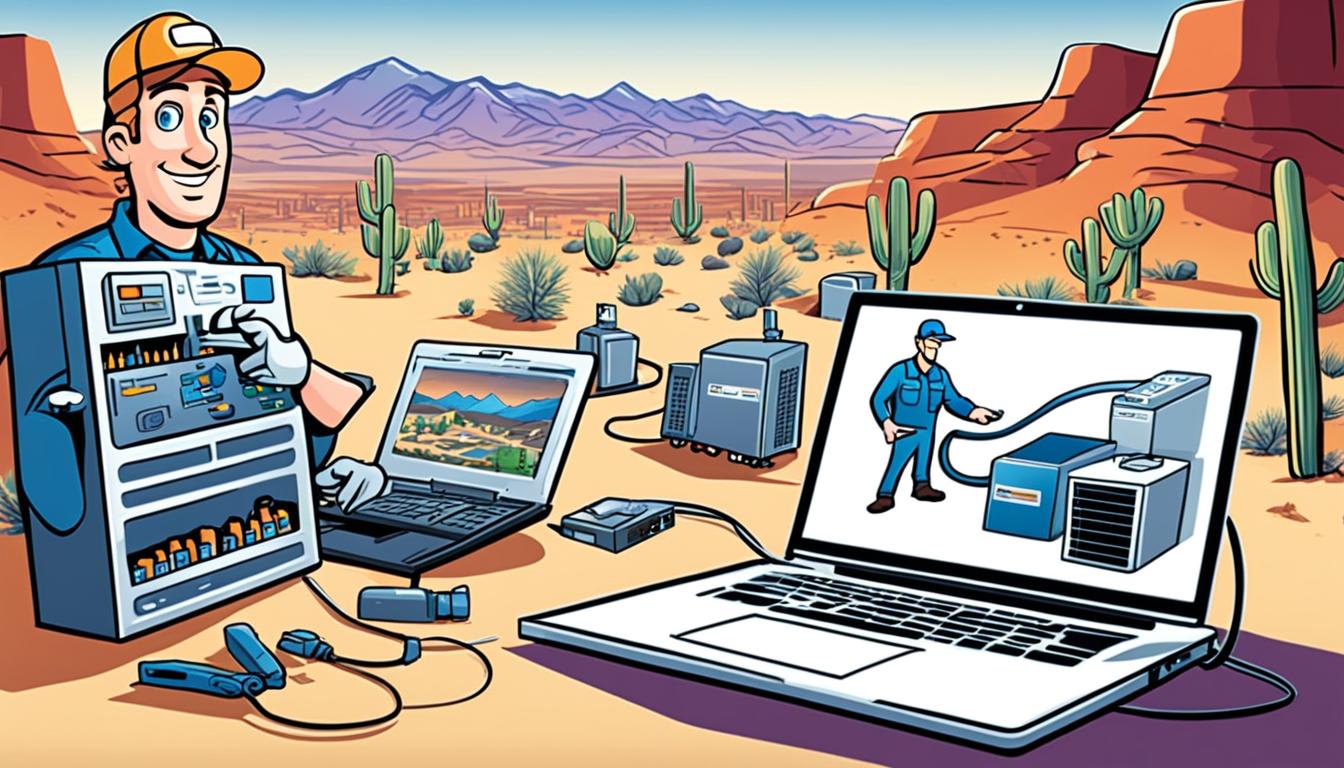Picture this: You’re in a tight, dimly lit space, methodically searching for a refrigerant leak. It’s not the most glamorous task, but it’s part of your job as an AC repair contractor. The air is stale, and beads of sweat form on your forehead as you concentrate on the task at hand.
But amidst the challenge, there’s one thing that should never be compromised: your safety. Whether you’re a seasoned professional or new to the field, taking proper precautions when using refrigerant leak detectors in confined spaces is of utmost importance.
By implementing the right safety measures, you can protect yourself and others from potential hazards and ensure that every job is carried out with the highest level of professionalism and care. So, let’s dive into the essential safety precautions you need to take when working with refrigerant leak detectors in confined spaces.
Key Takeaways:
- Regular safety checks on containers and systems are crucial to prevent accidents.
- Properly prepare safety equipment and procedures for unexpected releases.
- Minimize personal exposure to the refrigerant to reduce health risks.
- Be aware of the toxicity, flammability, and decomposition hazards associated with refrigerants.
- Ensure proper training and knowledge of OSHA standards and regulations.
The Hazards of Refrigerant Leak Detection: Toxicity, Flammability, and Decomposition
When it comes to refrigerant leak detection, it is crucial to be aware of the potential hazards associated with this process. Three main categories of hazards exist: toxicity, flammability, and decomposition. Understanding these risks will help you take appropriate safety measures to minimize accidents and ensure the well-being of yourself and others.
Toxicity of Refrigerants
Most refrigerants have undergone extensive toxicity testing and are classified based on their potential effects on human health. It is essential to be aware of the exposure levels and safety classifications of different refrigerants. Exposure to highly toxic refrigerants can cause serious health issues, including respiratory problems, skin irritation, and even long-term effects such as organ damage.
Flammability of Refrigerants
Some refrigerants have the potential to catch fire or explode when released into the air. These flammable refrigerants pose a significant risk and demand extra caution during leak detection activities. Ignition sources, such as electrical sparks or open flames, must be carefully controlled to prevent accidents. Always familiarize yourself with the flammability classifications of the refrigerants you are working with and implement appropriate safety measures.
Decomposition of Refrigerants
At high temperatures, refrigerants can decompose and produce potentially harmful byproducts. For example, some refrigerants may generate toxic gases like phosgene, which can be fatal in high concentrations. Decomposition can also result in the formation of corrosive acids. It is crucial to avoid exposing refrigerants to extreme heat to prevent decomposition and the release of hazardous substances.
To mitigate the risks associated with refrigerant leak detection, it is essential to follow safety guidelines and regulations. Use proper personal protective equipment (PPE) to minimize exposure, such as gloves, safety goggles, and respiratory protection. Regularly inspect and maintain your refrigerant leak detection equipment to ensure its functionality and accuracy. Additionally, consider implementing an effective ventilation system to remove any leaked refrigerant from the environment, reducing the risk of inhalation or ignition.
Being knowledgeable about the hazards of refrigerant leak detection and taking appropriate safety precautions will help create a safe working environment for both you and your team. Remember to consult manufacturer guidelines, adhere to industry standards, and undergo regular training to stay up-to-date with the latest safety practices.
Safety Guidelines for Working in Confined Spaces
When working in confined spaces, it is crucial to prioritize safety to protect yourself and others from potential hazards. Confined spaces are enclosed areas with limited entry or exit access, which can pose unique risks that require adherence to specific safety guidelines and regulations.
To ensure compliance and maintain a safe work environment, it is essential to follow the safety guidelines established by the Occupational Safety and Health Administration (OSHA). These guidelines provide comprehensive instructions on how to assess, mitigate, and prevent hazards associated with working in confined spaces.
Here are some key safety guidelines for working in confined spaces:
- Implement a written program: Develop a comprehensive written program addressing the potential hazards of confined spaces. This program should outline procedures, emergency response plans, and safety protocols specific to the confined spaces in your workplace.
- Train employees: Provide proper training to all employees involved in confined space work. This training should include awareness of potential hazards, proper equipment usage, and emergency procedures. Regular refresher training sessions should also be conducted to keep employees up-to-date with the latest safety practices.
- Use appropriate signage and barricades: Clearly mark and barricade confined spaces to ensure they are easily recognizable and inaccessible to unauthorized personnel. Visible signage should communicate the potential hazards and necessary precautions to those in the vicinity.
- Conduct air monitoring: Before entering a confined space, it is crucial to conduct air monitoring to assess the quality and presence of hazardous gases, vapors, or substances. This step helps to identify potential dangers and allows for the implementation of necessary safeguards.
- Differentiate between permit and non-permit confined spaces: Understand the distinction between permit-required and non-permit-required confined spaces. Permit-required spaces have additional hazards that necessitate specific safety measures and documentation. Ensure you adhere to the appropriate guidelines for each type of confined space.
- Ensure proper ventilation: Adequate ventilation is vital in confined spaces to control air quality and prevent the accumulation of harmful gases or vapors. Use mechanical ventilation systems or natural ventilation methods to maintain safe air conditions.
- Use personal protective equipment (PPE): Provide and require the use of appropriate PPE for all personnel entering confined spaces. This may include respiratory protection, protective clothing, gloves, and safety harnesses. Ensure that PPE is properly fitted, regularly inspected, and in good working condition.
- Continuous monitoring: Regularly monitor the confined space atmosphere during work activities to promptly detect any changes or hazards. Continuous monitoring devices can provide real-time data and alerts, allowing for immediate action if unsafe conditions arise.
By following these safety guidelines for working in confined spaces, you can reduce the risk of accidents, injuries, and potentially life-threatening situations. Prioritizing safety not only protects your employees but also ensures compliance with OSHA regulations, creating a culture of safety within your organization.
| Confined Space Hazards | Precautions |
|---|---|
| Toxic Atmospheres |
|
| Oxygen Deficiency/Enrichment |
|
| Flammable/Explosive Atmospheres |
|
| Engulfment or Entrapment |
|
| Physical Hazards |
|
Common Hazards Associated with Refrigeration Systems
Refrigeration systems play a vital role in preserving food and maintaining comfortable environments, but they are not without their share of hazards. In the refrigeration industry, accidents can occur due to mechanical or general causes, such as electrical hazards, eye injuries, and accidents during equipment erection and dismantling.
Furthermore, specific hazards are associated with refrigeration systems that require careful attention. Leaking refrigerants pose the risk of asphyxiation, while gases released from refrigerated products can also be hazardous. Inadequate safety measures can lead to fire hazards and even frostbite. It is crucial to be aware of these common hazards and take appropriate precautions to prevent accidents.
To enhance safety in the refrigeration industry, proper training is essential. By equipping workers with knowledge of potential hazards and promoting awareness, companies can minimize the risks associated with refrigeration systems. Adherence to safety guidelines, such as regular maintenance and inspections, ensures the optimal functioning of equipment and reduces the likelihood of accidents. Prioritizing safety in all aspects of refrigeration operations is crucial for protecting both workers and the environment.





0 Comments